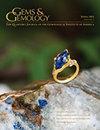Geographic Origin Determination of Blue Sapphire
IF 1.6
3区 地球科学
Q2 MINERALOGY
引用次数: 19
Abstract
GEMS & GEMOLOGY WINTER 2019 The twentieth century witnessed a surge of discoveries of blue sapphire deposits around the world. As the gem trade has evolved alongside these developments, geographic origin determination has become a major consideration in buying and selling sapphires. In some cases, the value of a stone can depend strongly on its origin, such as the Kashmir sapphires shown in figure 1. The trade largely relies on reputable gemological laboratories to make these origin determinations, which are based on comparison with extensive reference collections (see Vertriest et al., 2019, pp. 490–511 of this issue) and advanced analytical methods (see Groat et al., 2019, pp. 512–535 of this issue). After more than a decade of efforts by GIA’s field gemology and research departments to acquire reliable samples in the field and collect reference data, blue sapphire remains one of the greatest challenges when it comes to origin determination. The following sections will detail the origin data GIA has collected for blue sapphire and describe the laboratory’s methodology for using this data in geographic origin determination.蓝蓝宝石的地理起源测定
2019年冬季宝石与宝石20世纪,世界各地发现了大量的蓝色蓝宝石矿床。随着宝石贸易的发展,地理原产地的确定已成为买卖蓝宝石的主要考虑因素。在某些情况下,石头的价值在很大程度上取决于其来源,例如图1所示的克什米尔蓝宝石。该行业在很大程度上依赖于声誉良好的宝石学实验室来进行这些原产地测定,这些测定是基于与广泛的参考文献集(见Vertriest等人,2019,本期第490–511页)和先进的分析方法(见Groat等人,2019年,本期的第512–535页)的比较。经过GIA的实地宝石学和研究部门十多年的努力,在实地获得可靠的样本并收集参考数据,蓝宝石仍然是确定原产地的最大挑战之一。以下章节将详细介绍GIA为蓝蓝宝石收集的原产地数据,并描述实验室在地理原产地确定中使用这些数据的方法。
本文章由计算机程序翻译,如有差异,请以英文原文为准。
求助全文
约1分钟内获得全文
求助全文
来源期刊

Gems & Gemology
地学-矿物学
CiteScore
2.90
自引率
19.20%
发文量
10
期刊介绍:
G&G publishes original articles on gem materials and research in gemology and related fields. Manuscript topics include, but are not limited to:
Laboratory or field research;
Comprehensive reviews of important topics in the field;
Synthetics, imitations, and treatments;
Trade issues;
Recent discoveries or developments in gemology and related fields (e.g., new instruments or identification techniques, gem minerals for the collector, and lapidary techniques);
Descriptions of notable gem materials and localities;
Jewelry manufacturing arts, historical jewelry, and museum exhibits.
 求助内容:
求助内容: 应助结果提醒方式:
应助结果提醒方式:


